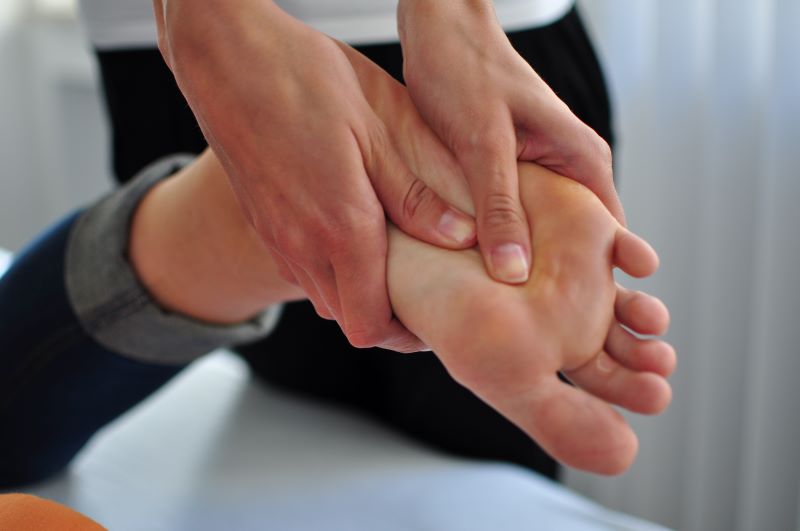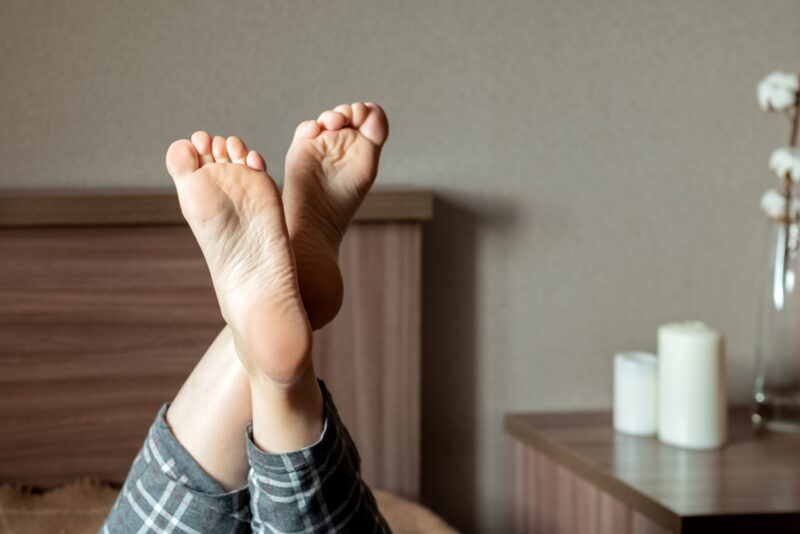Flat foot reconstruction is a process that involves surgery and other methods to restore the arch to a person’s foot. Flat feet can be painful and uncomfortable, and lead to other complications that affect a person’s everyday life. Somewhere between 8 and 25 percent of people aged 21 and older suffer from this condition, so it affects a large amount of the population. In many cases, flat feet can actually be painless, but when it starts to cause pain it can be very difficult to function normally. Once pain begins, flat feet treatment often involves surgery because of the need for reconstructing the ligaments and tendons. Flat feet reconstruction is considered a low-risk operation, offers an opportunity for a better quality of life, and has long-term benefits for patients with a return to activity. We can help assist patients who need flat foot surgery in Algonquin and surrounding areas.
 What Is Flat Feet?
What Is Flat Feet?
Essentially, the condition known as flat feet involves a person’s arch in their foot collapsing when standing or putting weight on them. This is due to the tendons and ligaments not holding their shape. The arch of the foot acts like a springboard, and helps prevent tension and wear on the bones of the feet. When a person’s arch collapses partially or fully, it affects their ability to walk properly and the bones can even break or become deformed over time. Flat feet occur in people of all ages, but are most prevalent in children and older patients. For children, flat feet can occur because their arches aren’t developing properly. In elderly patients, it is usually due to wear and tear. Athletes also often develop flat feet due to injury.
Symptoms of Flat Feet
The biggest symptom of flat feet is pain while walking, usually in the heel or arch area. Some patients also report swelling on the inner portion of the foot and ankle. Most of the time these symptoms worsen with physical activity.
Nonsurgical Flat Feet Treatment
While flat feet reconstruction is mostly surgical, there are many nonsurgical treatments for flat feet. Most doctors will try nonsurgical treatments first, but move to surgery if things do not improve for the patient. It is often difficult to figure out how to fix flat feet, even after a proper diagnosis. Some treatments involve total bed rest for a certain period of time, ice therapy, wearing specialized orthotic inserts or footwear, cortisone injections, and physical therapy. For patients with partial arch collapse, these can be especially effective. Depending on the health of the patient and other factors, doctors may not recommend these treatments and might go straight to surgical interventions. For example, not every patient can undergo physical therapy. Flat feet treatment usually takes several months to provide a difference.
 Flat Foot Reconstruction
Flat Foot Reconstruction
Because flat feet vary so greatly, flat foot reconstructive surgeries vary as well. Most of these are considered to be non-invasive and have low complication rates. There are several kinds of reconstructive surgeries doctors have proven are likely the best ways how to fix flat feet long term. Many of these types are available as a flat foot surgery in Algonquin.
Internal Fixation
This surgery is most often used for flat feet reconstructions in patients with arch injuries. This realigns the bones in the foot using hardware, which the surgeon removes after about 3-5 months. This gives the bones time to heal properly after damage, correcting flat feet.
Implants
An implant called a subtalar implant is also a great option for patients with arch injury. This is a small implant that a surgeon places to help support the arch, and tissue can actually grow around it to help it stay in place. This implant also helps patients prevent rolling their ankle.
Fusion
This type of surgery is most commonly performed on patients with arthritis because the bones are often fragile and the foot may not be flexible enough for other procedures. There are several options for fusion, including fusing one or more joints to create the arch again. Foot fusion surgeries work by removing all of the local cartilage and replacing it with bone grafts, which heal and fuse the bones together. This type of flat foot reconstruction takes longer to heal but often lasts a long time with significant results. It does result in less flexibility, but many patients at this stage need stability and feel this is the best route for flat foot reconstruction.
Tendon Lengthening
The Achilles tendon sits at the back of the foot and connects to the back of the heel. A simple way to deal with flat feet, especially for children or younger people, is by lengthening the calf muscles and reattaching the Achilles tendon. This surgery can prevent flat feet from returning at a later date.
Tendon Transfer
This surgery essentially rebuilds the tendon in the arch of the foot by removing it entirely or partially and transferring another tendon to the arch. This can be very effective but also might not prevent flat feet from occurring again if there are other complications. If the same causes continue, the transferred tendon could become damaged as well. This is why this surgery is mostly recommended for genetic issues or torn or injured tendons.
Reconstruction of Foot Bones
Sometimes the best option for flat foot reconstruction is completely restructuring the foot. This can mean removing and replacing some bones, moving them, and even reshaping some of them. This could be along the arch itself or even in the heel. This surgery has a bit longer recovery time, but is often one of the best long-term solutions for how to fix flat feet.
 Flat Foot Surgery in Algonquin
Flat Foot Surgery in Algonquin
If you are suffering from flat feet or searching for flat foot surgery in Algonquin, contact us today to set up an appointment. We can help you find the right treatment plan to help you with your flat foot reconstruction, either with or without surgery.

